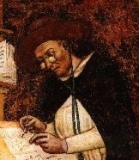 Tommaso da Modena, Hugh of Provence (1352)
Tommaso da Modena, Hugh of Provence (1352)
Recently Susan Higginbotham of the American Branch of the Richard III Society made a remark that Robert Dudley, Earl of Leicester, purchased a number of pairs of “spactakells” for himself during the years 1584 to 1586.[1] Reading this, squinting at my computer screen because I had forgotten my own reading glasses somewhere else, made me wonder whether Richard III approx. 100 years before Dudley would have had access to glasses. He might very well have needed them, had he been allowed to grow old. Presbyopia, where the ability to focus on near objects is diminished, is one of the symptoms caused by the natural course of aging.[2]
The oldest known lens was found in the ruins of ancient Nineveh and was made of polished rock crystal, an inch and one-half in diameter. However, these early lenses do not seem to have been suitable as a reading aid, they are referred to for burning holes in parchment and for erasing writing from wax tablets. Pliny mentions them for cauterizing wounds.[3]
The first step to help sufferers of presbyopia was the reading stone, which was in use during the 12th and 13th centuries. This is a crude plano-convex shape with a simple wooden frame which could be laid against a manuscript in order to magnify even the tiniest letters, basically something like a magnifying glass today.
The first eyeglasses were created around 1286-1287 by an unknown artisan likely from Pisa, Italy. We know this from documents by two monks, associated at the St. Catherine of Alexandria Monastery, who also promised to keep the invention secret – fortunately they did not succeed. Possibly the artisan had held lenses in front of each eye simultaneously and, by connecting the handles of the two glasses with a rivet, he created the first reading glasses.
From Italy spectacle making spread during the 14th century to the Low Countries and from there to Germany and France. Customs records from London show that from the 14th century onwards, spectacles were being imported from the Low Countries in bulk, before being produced in England in the late 15th. A Paul van de Bessen (an immigrant from the Low Countries?) made spectacles in Southwark around 1458-9. The 1547 inventory of Henry VIII’s estate includes horn spectacles. The Worshipful Company of Spectacle Makers was established in 1629.[4] Their motto was “A blessing to the aged”.[5]
The earliest glasses discovered thus far are an incomplete pair of rivet spectacles from around 1330 which were found under the floorboards of the nun’s choir-stalls at Kloster Wienhausen in northern Germany. Similar finds dating to the early 15th century have also been made in London.[6]
While researching this topic I came across the depiction and description of the Orders of Angels Window in All Saints, North Street, in York. This stained glass window from the 15th century shows the Nine Orders of Angels, where a representative angel of each order leads a procession of mortals of the appropriate rank in medieval society, starting with a group of top level clerics down to some working men and women. There is a labourer with a spade, a tanner with his tools, a woman with a basket and also a man holding up a pair of spectacles to his eyes.[7] You can see this endearing detail of the window here. It is interesting that it is the labourer who is depicted with the glasses, the typical user would have been an educated elderly resident of a monastery or another member of the literate minority.[8]
The first artistic depiction of eyeglasses was the above 1352 portrait of Hugh of Provence by Tommaso da Modena. The author of the New York Carver page says of this painting:
Then, as now, the wearing of eyeglasses somehow evoked an air of thoughfulness, and the use of spectacles as a subject detail – in both medieval and early Renaissance painting – would soon come to symbolize a wealth of education and wisdom…[9]
Surely this would be an apt description of Richard III.
Notes:
1 Susan tells us that this information comes from Simon Adams’ edition of Robert Dudley’s household accounts from 1584-1586. Robert Dudley, Simon Adams (ed), Household Accounts and Disbursement Books of Robert Dudley, Earl of Leicester. Camden Fifth Series (No. 6), Cambridge University Press, 1995, ISBN-13: 9780521551564.
2 “Presbyopia”, Wikipedia, accessed 6 Sept 2010. http://en.wikipedia.org/wiki/Presbyopia
3 Drewry, Richard D, “What Man Devised That He Might See”, Teagle Optometry, accessed 6 Sept 2010.
4 “Rivet Spectacles – The Earliest Style”, Antique Spectacles and other Vision Aids: The On-Line Museum and Encyclopedia of Vision Aids, accessed 6 Sept 2010. This page also includes a great number of pictures.
5 Drewry
6 “Eyeglasses Through the Ages”, Antique Spectacles and other Vision Aids: The On-Line Museum and Encyclopedia of Vision Aids, accessed 6 Sept 2010. See also: “Chart of Known Examples”, Antique Spectacles and other Vision Aids: The On-Line Museum and Encyclopedia of Vision Aids, accessed 6 Sept 2010.
7 “The Stained Glass of All Saints”, All Saints Church, North Street, York, accessed 6 Sept 2010.
8 “Rivet Spectacles – The Earliest Style”
9 “Medieval Inventions: Eyeglasses”, New York Carver – Medieval stone, art, architecture…and the Middle Ages, accessed 6 Sept 2010.
Tags: Medieval Life, Richard III

Leave a reply